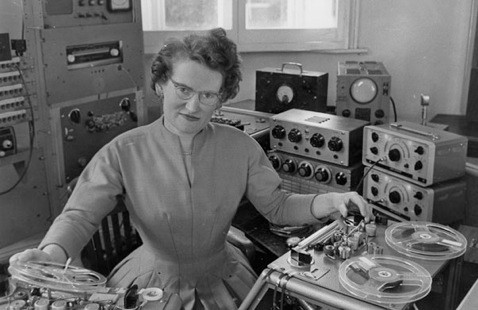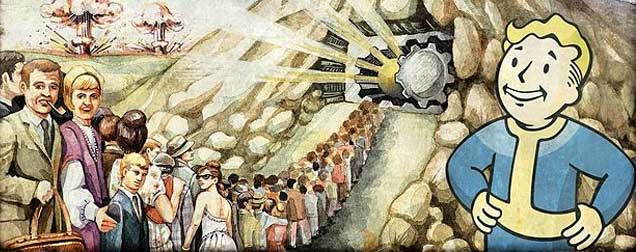Daphne Oram

Real Name: Daphne Blake Oram
Profile: Daphne Oram (born December 31, 1925) worked for the BBC from 1943 firstly as a sound engineer, and then as the co-founder and Director of the "Radiophonic Workshop" from 1958 until she set up her own studio Folly Tower, so that she could make her own music, not just creating sounds to be used as special effects. She also created a musical machine that converted pictures into sound, known as 'Oramics' which she later continued working on, with the onset of the home computer revolution in 1981.
After suffering a stroke in 1994 she sadly had to give up her life-long work, and retired to a nursing home were she died on the 23rd January 2003 aged 77.
В общем, эта женщина стояла у истоков электроакустики, шумовой импровизационной конкретной музыки. Я, признаться, отнюдь не любитель всякого там олд-скула и не люблю, когда в сравнение современным музыкантам приводят кого-то из эпохи динозавров... вообще считаю это сравнение некорректным да и в подавляющем большинстве случаев мне старая музыка совсем не нравится, режет слух.. ощущение несовершенности тогдашних технологий непокидает.. Но вот с этим диском у меня совсем другая история!!! Эта музыка записана в период 1958-1977. Исполнялась она на некоей машине, которая называлась Oramics, которая переводила изображение в звук... Как известно, аппарат, в основе которого лежала аналогичная концепция еще в начале 20в был создан в России и назывался АНС. Единственная его копия сейчас хранится где-то в подвале Петербургского университета.. На этом АНСе Coil даже умудрились записать целый альбом) Возвращаясь к сути.. я был невероятно поражен звуком на альбоме. Музыка звучит очень сочно, басовито, мощно.. Звук не похож ни на что из области электронники того времени. Музыка разбавлена различными звуковыми коллажами, речью людей, звуками улиц, природы и т.п. От этого в целом складывается очень позитивное настроение альбома, не смотря на жуткое и бескомпромиссное звучание отдельных треков. Сложно все-таки внятно объяснить чем конкретно так хороша для меня эта музыка.. Надо просто внимательно прослушать альбом от начала и до конца) Все вместе ИМХО звучит очень свежо и интересно.
Статья с guardian.co.uk "Daphne Oram: Portrait of an electronic music pioneer"
As the BBC Radiophonic Workshop celebrates its 50th anniversary, we pay tribute to the life and legacy of its co-founder Daphne Oram, one of the pioneers of British electronic music
There are many histories of electronic music. Some focus on the avant-garde studios active in Europe, America, Russia and the old eastern bloc countries, and usually mention the work of Karlheinz Stockhausen, Pierre Schaeffer, Luciano Berio, John Cage and others. There are other stories that focus on popular music: Kraftwerk, the Human League, Depeche Mode and Aphex Twin. And there are more esoteric studies that mention Raymond Scott, Louis and Bebe Barron, Tom Dissevelt and Kid Baltan. Yet, however hard you look into the history of electronic music, there is one name you'll struggle to find – that of Daphne Oram.
Oram was one of the first British composers to produce electronic sound, a pioneer of what became "musique concrete" – music made with sounds recorded on tape, the ancestor of today's electronic music. Her story makes for fascinating reading. She was born in 1925 when Britain was between two world wars. She was extremely bright, and studied music and electronics – unusual at the time not only because electronics was an exciting new industry, but also because it was a man's world.
She went on to join the BBC, and, while many of the corporation's male staff were away fighting in the second world war, she became a balancing engineer, mixing the sounds captured by microphones at classical music concerts. In those days, nearly all programmes went out live because recording was extremely cumbersome and expensive. Tape hadn't been invented, and cheap computers were half a century away.
Yet when tape did come along, in the early 1950s, Oram was quick to realise that it could be used not simply for recording existing sounds, but for composing a new kind of music. Not the music of instruments, notes and tunes, but the music of ordinary, everyday sound.
After Oram had finished her day's work, and everyone had gone home, she trundled tape recorders the size of industrial gas cookers from empty studios, and gathered them to experiment late into the night. She recorded sounds on to tape, and then cut, spliced and looped them; slowed them down, sped them up, played them backwards. It must have been like working in a laboratory, or inventing new colours – a new world almost impossible to imagine now.
Unfortunately – perhaps inevitably – nobody at the BBC was interested. Still Oram kept going. She badgered senior figures to set up a department producing experimental sound works, only to be told that the BBC had several orchestras capable of producing all the sounds that were needed.
Eventually, however, a committee looking into "Electrophonic Effects" was set up, and Oram shared the results of her experiments. But still they didn't want her to be involved. "They wanted my work," she later said, "but they didn't want me." So she teamed up with another recording engineer, Desmond Briscoe, and in 1958, 16 years after Oram first joined the BBC, the pair were given a spare room in the Maida Vale studios, along with some out-of-date equipment, and left alone to get on with it. To avoid complications with the orchestras, the Musicians' Union and the BBC music departments, they had to avoid the word "music" entirely, so they called the project something else. The BBC Radiophonic Workshop was born.
Within a few months of founding one of the most famous music studios in the world, however, Oram left. There was a clash of ambitions. She wanted to develop an experimental institution, like those in Paris, Cologne and Milan, producing electro-acoustic music by international avant-garde composers of the day. The BBC, yet again, had other ideas: it wanted a sound-effects factory producing jingles for schools programmes and radio drama.
So Oram set up on her own in a deserted oast house in Kent. Here she built an astonishing contraption, the "Oramics" machine, which produced pure electronic sound. It was about the size of a chest of drawers and was constructed from metal shelving materials. Electric motors pulled eight parallel tracks of clear 35mm film stock across scanners that operated like TV sets in reverse. On the film she drew curving black lines, squiggles and dots, all converted into sound. It looked and sounded strikingly modern.
Although she was rumoured to have been visited by members of The Beatles, the Rolling Stones and The Who, as well as the avant garde of the day, Oram was bypassed by the music establishment – at least until now. Her archive is at last being catalogued and cherished at Goldsmiths College in London. Recently, the South Bank Centre devoted a whole day to her work. A double CD has been released, and very soon a digital version of the Oramics machine will be available online. We're 40 years too late, but it seems we might finally catch up with the astonishing life and legacy of Daphne Oram.
Daphne Oram - Oramics (2007)

Label: Paradigm Discs
Catalog#: PD 21
Format: 2 x CD, Compilation
Country: UK
Released: Jan 2007
Genre: Electronic
Style: Abstract, Musique Concrète, Experimental
Credits: Artwork By - Clive Graham
Music By - Daphne Oram
Notes: Selection of works from the archives of Daphne Oram who is known best for the design of her Oramics system, and also for co-founding the BBC Radiophonic Workshop in 1958.
All tracks are from the post BBC era 1958-1977 and recorded in her home studio Tower Folly, Kent.Tracklisting:
1-1 Introduction
1-2 Power Tools
1-3 Bird Of Parallax
1-4 In A Jazz Style
1-5 Purring Interlude
1-6 Contrasts Essconic
1-7 Lego Builds It
1-8 Pompie Ballet (Excerpt)
1-9 Intertel
1-10 Adwick High School No.1
1-11 Look At Oramics
1-12 Rotolock
1-13 Purple Dust
1-14 High Speed Flight
1-15 Studio Experiment No.1
1-16 Four Aspects
1-17 Kia Ora
1-18 Dr. Faustus Suite
1-19 Adwick High School No.2
1-20 Tumblewash
1-21 Studio Experiment No.2
1-22 Snow
2-1 Rockets In Ursa Major (Excerpt 1)
2-2 Food Preservation
2-3 Studio Experiment No.3
2-4 Bala
2-5 Episode Metallic
2-6 Studio Experiment No.4
2-7 Adwick High School No.3
2-8 Fanfare Of Graphs
2-9 Studio Experiment No.5
2-10 Brocilliande
2-11 Mary Had A Little Lamb
2-12 Incidental Music For Invasion (Excerpts)
2-13 Costain Suite
2-14 Rockets In Ursa Major (Excerpt 2)
2-15 Passacaglia
2-16 Missile Away
2-17 Pulse Persephone
2-18 Adwick High School No.4
2-19 Nestea
2-20 Rockets In Ursa Major (Excerpt 3)
2-21 Conclusion
2-22 Studio Jinks
http://www.mediafire.com/download.php?i9c3e781cf3febo
http://www.mediafire.com/download.php?r00m1kiatyu0e5b
Отредактировано SubtLe (2008-08-19 01:26:25)



